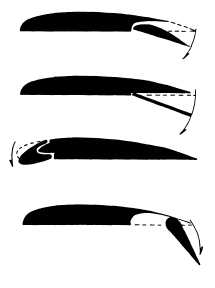patrol aircraft. The rudder is operated by foot pedals on
all types of aircraft.
Secondary Group
The secondary group includes the trim tabs and
spring tabs. Trim tabs are small airfoils recessed into
the trailing edges of the primary control surface. Each
trim tab hinges to its parent primary control surface, but
operates by an independent control. Trim tabs let the
pilot trim out an unbalanced condition without exerting
pressure on the primary controls.
Spring tabs are similar in appearance to trim tabs
but serve an entirely different purpose. Spring tabs are
used for the same purpose as hydraulic actuators. They
aid the pilot in moving a larger control surface, such as
the ailerons and elevators.
Auxiliary Group
The auxiliary group includes the wing flaps,
spoilers, speed brakes, and slats.
WING FLAPS.—Wing flaps give the aircraft
extra lift. Their purpose is to reduce the landing speed.
Reducing the landing speed shortens the length of the
landing rollout. Flaps help the pilot land in small or
obstructed areas by increasing the glide angle without
greatly increasing the approach speed. The use of flaps
during takeoff serves to reduce the length of the takeoff
run.
Some flaps hinge to the lower trailing edges of the
wings inboard of the ailerons. Leading edge flaps are
used on the F-14 Tomcat and F/A-18 Hornet. Four
types of flaps are shown in figure 4-10. The plain flap
forms the trailing edge of the airfoil when the flap is in
the up position. In the split flap, the trailing edge of the
airfoil is split, and the lower half is hinged and lowers to
form the flap. The fowler flap operates on rollers and
tracks, causing the lower surface of the wing to roll out
and then extend downward. The leading edge flap
operates like the plain flap. It is hinged on the bottom
side. When actuated, the leading edge of the wing
actually extends in a downward direction to increase
the camber of the wing. Landing flaps are used in
conjunction with other types of flaps.
SPOILERS.—Spoilers are used to decrease wing
lift. The specific design, function, and use vary with
different aircraft. On some aircraft, the spoilers are long
narrow surfaces, hinged at their leading edge to the
upper surfaces of the wings. In the retracted position,
they are flush with the wing skin. In the raised position,
they greatly reduce wing lift by destroying the smooth
flow of air over the wing surface.
SPEED BRAKES.—Speed brakes are movable
control surfaces used for reducing the speed of the
aircraft. Some manufacturers refer to them as dive
brakes; others refer to them as dive flaps. On some
aircraft, they're hinged to the sides or bottom of the
fuselage. Regardless of their location, speed brakes
serve the same purpose—to keep the airspeed from
building too high when the aircraft dives. Speed brakes
slow the aircraft's speed before it lands.
SLATS.—Slats are movable control surfaces that
attach to the leading edge of the wing. When the slat is
retracted, it forms the leading edge of the wing. When
the slat is open (extended forward), a slot is created
between
the
slat
and
the
wing
leading
edge.
High-energy air is introduced into the boundary layer
over the top of the wing. At low airspeeds, this action
improves the lateral control handling characteristics.
This allows the aircraft to be controlled at airspeeds
below normal landing speed. The high-energy air that
flows over the top of the wing is known as boundary
layer control air. Boundary layer control is intended
primarily for use during operations from carriers.
Boundary layer control air aids in catapult takeoffs and
arrested landings. Boundary control air can also be
accomplished by directing high-pressure engine bleed
air across the top of the wing or flap surface.
4-10
SPLIT FLAP
LEADING EDGE FLAP
PLAIN FLAP
FOWLER FLAP
ANf0410
Figure 4-10.—Types of flaps.


